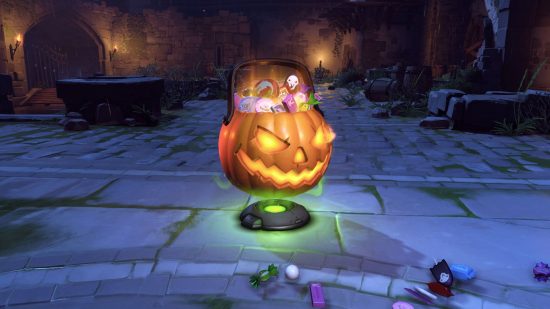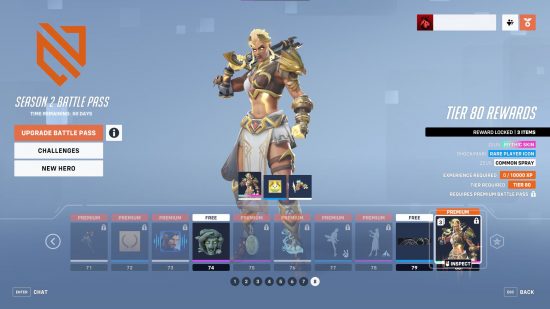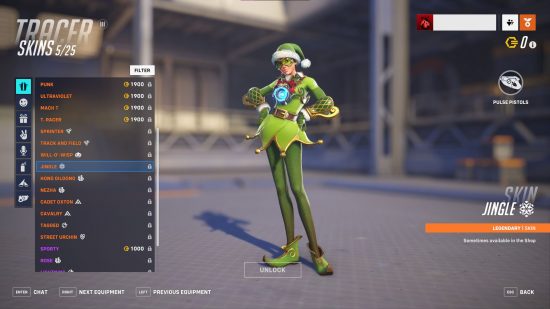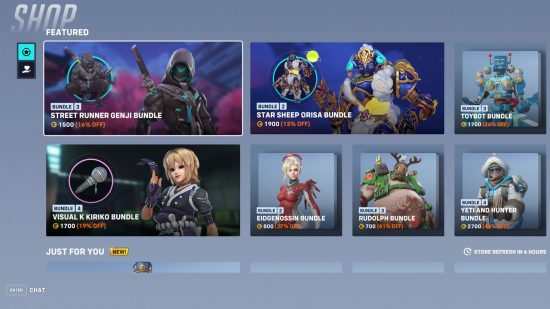Overwatch 2’s monetisation system is a bit of a mess at the moment, and that’s putting it mildly. Blizzard’s hit FPS sequel has been roundly criticised by its own community for disregarding players less inclined to dip their toes into premium purchases, and it’s not difficult to see a glimmer of truth in the accusation. So far, both Overwatch 2 seasons have included a free battle pass that’s been populated with a meagre offering of low-value victory poses, sprays, and portraits – all of which pale in comparison to its premium counterpart.
If you’re a free-to-play consumer, you can forget the highly coveted mythic skins splashed over the main menu that sit at the culmination of the premium Overwatch 2 battle pass. The free version of the battle pass doesn’t even include legendary items. Do you like new and exciting cosmetics for your favourite heroes? Do you like reaping the rewards of your hard-won victories in a live-service videogame? Tough ta-tas, because Overwatch 2 doesn’t care… unless you’re paying for it.
May the odds be never in your favour
Loot boxes suck. Did we mention that yet? We probably don’t need to; numerous studies have concluded that loot boxes are psychologically aligned with gambling, and that their influence disproportionately affects vulnerable consumers. As a response to these findings, multiple countries have quite rightly moved to block loot boxes appearing in their most predatory forms.
Belgium took a more comprehensive stance back in 2018, enforcing a blanket ban on loot boxes altogether. While recent reports have questioned the efficacy of this ban, it’s certainly worth mentioning that Overwatch was one of the case studies used by the Belgian Gaming Commission to determine that loot boxes constitute illegal gambling. It’s not exactly surprising that Blizzard would seek to distance itself from that report by switching up its monetisation system in the multiplayer game’s sequel, but it certainly doesn’t mean the alternative is more consumer-friendly.
Let’s crunch some numbers, shall we? Back in the day, a loot box in Overwatch contained four random cosmetics, with a guarantee to receive at least one rare or better item in every box. Of course, it’s worth bearing in mind that this extended to all cosmetics, including the 600+ ‘rare’ portraits that diluted the chances of receiving far more desirable items. The rarest, those coveted legendary skins, had a 7.5% chance to drop.
While 7.5% is objectively terrible odds, consider Genshin Impact’s woeful 0.6% drop rates for its 5-star characters. Additionally, while Overwatch players could purchase loot boxes with in-game or real-world currency, it wasn’t a requirement, since you automatically received a loot box after each level gained. Of course, the higher your level, the more experience was required to reach the next level, which functioned as the quintessential gambling hook of showering new players in loot boxes only to slowly cut them off, forcing them to work harder for their next ‘hit’ – or reach for their wallet.
A pass or a fail?
So now we’ve established the level of evil at which Overwatch loot boxes operated, let’s get stuck into the Overwatch 2 premium battle pass and how it stacks up against others of its ilk. Overwatch 2’s battle pass mostly consists of cosmetic rewards, and includes a 20% experience bonus that serves as insurance against complaints that more casual players aren’t putting in enough hours to unlock the rewards after paying for access to them.
Obviously, there are many other free PC games with this structure. Fortnite is the prime example and the clear inspiration behind Overwatch 2’s battle pass. The crucial difference between the two is that dedicated players can earn enough V-Bucks while completing the Fortnite battle pass to purchase the next one without spending real money. Meanwhile, the Overwatch 2 battle pass costs 1,000 Coins, which you can only earn for free through weekly challenges… for a maximum of 60 coins a week.
I promised you number-crunching, so here’s something to really chew on: it would take you 16 weeks to earn enough coins for one battle pass in Overwatch 2. Given that Overwatch 2’s seasons run on a nine-week schedule, you’d be spending almost two seasons just saving up for a single pass.
And let’s not forget, loot boxes might be entirely cosmetic, but the Overwatch 2 battle pass certainly isn’t. Unlike the previous iteration of Overwatch, new heroes like Kiriko and Ramattra are only available to unlock via their season’s battle pass. Of course, if you purchase the premium battle pass, you gain immediate access. If you’re looking to acquire new Overwatch 2 characters without spending any money, though, it’s going to take some dedication.
Each tier of the Overwatch 2 battle pass requires 10,000 XP, and you’d have to earn 450,000 XP to unlock Ramattra. Aside from the 118,000 XP up for grabs per week via challenges, regular matches in Overwatch 2 grant you a measly 100 to 150 XP. It doesn’t take a mathematician to conclude that, unlike other battle passes which serve to encourage player engagement, the Overwatch 2 battle pass is built on breadcrumbs.
The season of giving, and giving, and giving
If we’re talking cosmetic microtransactions, we can’t overlook Overwatch’s seasonal events. These holiday celebrations are always accompanied by an array of diverse and colourful new skins up for grabs, many of which serve to marry the festivities with the personalities of the FPS game’s characters. The Overwatch 2 Halloween event continued this tradition, introducing a selection of delightfully spooky skins… that are only available to purchase through the shop.
Seasonal skins have always had limited-time availability, but these restrictions made a degree of sense since they were tied to the events themselves. Seasonal challenges grant seasonal rewards – it makes sense, right? However, It’s during these seasonal events that Overwatch 2’s monetisation system goes mask-off by constantly pushing its players towards the shop. Skins are available on a weekly rotational basis, and there’s no easy way of checking what’s currently available without engaging with the storefront, with its alluring bundles and percentage reductions.
If you’re looking to unlock a specific legendary skin in the shop, it’ll take 1,900 coins. That’s roughly 31 weeks of in-game grinding, or in real-world money, about $20. Let’s get real here, there’s nothing micro about that transaction – but you best make your mind up quickly, because in a week’s time that skin will disappear, and who knows when it’ll be available again.
The combination of skin availability being tied to seasonal battle passes and seasonal events also makes for a miserly view from Overwatch 2’s hero gallery. Aside from her two default skins, only eight of Tracer’s 25 skins can currently be unlocked with in-game coins, and this disparity between available skins and gated premium skins is guaranteed to become more egregious as more seasons – and more skins – make their debut.
Two evils, both alike in indignity
So, loot boxes suck. Battle passes suck. Digital storefronts for microtransactions suck. There are probably a few of you out there thinking, well, what’s the big deal? Everything’s cosmetic, and it’s the gameplay that we should be focusing on – which is free! Why all the hullabaloo?
Well, it’s pretty simple: it’s hard to care about a game that actively doesn’t care about you. Overwatch 2 splashes new content across its main menu that you either have to pay for or spend a gruelling amount of time grinding towards, with the meagre offerings drip-fed along the way designed to push you towards taking the easier, quicker route and just giving Blizzard your money.
Obviously, skins aren’t everything, but let’s not forget: it’s not just skins. The debut of new heroes was a marketing boon for Blizzard, drawing wayward fans back into the fold and potentially locking them in for the long haul. Heroes were playable for everyone, but now, there’s a sizeable chunk of the community who will go into the next season that didn’t have the time or money to unlock Ramattra or Kiriko, and will be prohibited from playing either of them in regular matches for the foreseeable future.
The more Overwatch presents a closed door to casual players, the more player attitudes will tip towards no longer taking an interest, and the divide between the ‘haves’ and the ‘have-nots’ will widen. Overwatch’s loot box system was a psychological minefield, where all the best rewards always seemed just out of reach. With the Overwatch 2 battle pass, everything seems out of reach. Everything is gated off, everything makes you wait, whether that’s a skin appearing in the shop or a new character locked behind a lofty tier in the battle pass. It’s a bucket of cold water sluicing through the excitement of a new event or season, and it doesn’t bode well for the community’s future. The loot boxes may be gone, but we’re still in a psychological minefield; the landscape may be different, but the danger is the same.




